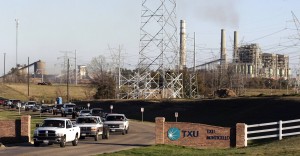A Changing Market and Dim Future for Coal in Texas

Photo by REUTERS/Mike Stone /Landov
A stream of workers leave the TXU Monticello power plant near Mt. Pleasant, Texas February 26, 2007.
Amid the continued decline in coal power in the state, Texas’ largest power generator is asking the state for permission to idle another of its coal power units this winter. And new federal regulations proposed today make it unlikely that many new coal power plants will be built in the foreseeable future.
Luminant, a division of the financially-troubled Energy Future Holdings, is asking operators of the Texas grid if it can suspend one unit at its Martin Lake coal plant in Northeast Texas. It’s similar to another request by the company — already granted last year and again this year — to suspend two other units at the large Monticello coal power plant in the same region.
While there’s been plenty of talk over the last few years of a regulatory “War on Coal,” the culprit behind coal’s slowdown in Texas is something far different: the free market.
“We want to operate as much of our generation as we can,” says Brad Watson, a spokesperson for Luminant. “But it just doesn’t make sense, economic sense, to operate a unit at a financial loss.” Citing “persistently low prices” for power in the deregulated Texas market, Luminant has decided its better to just close these coal units for a large part of the year, a decision Watson says the company “doesn’t like.”
Coal power faces an uphill battle in Texas. On top of a market friendlier to cheap natural gas, new carbon rules from the Environmental Protection Agency (EPA) announced today will sharply limit the development of new coal projects in the country. Plants will be required to capture some or all of their carbon emissions, a step that would likely prove too costly and lead generators to opt for natural gas (which will have a much easier time meeting the new standards) or renewable energy instead. Coal is more carbon-intensive than any other fuel, and has been the top culprit of carbon dioxide emissions in the world for the last ten years.
The EPA is also considering new carbon rules for existing power plants, which could have a big impact on the state’s coal power fleet. “That’s really where the rubber hits the road,” says Jonas Monast, Director of the Climate & Energy Program at Duke University’s Nicholas Institute for Environmental Policy Solutions. “Because relatively there are a small number of new power plants built every year in this county. But there are a large number of existing power plants that, depending on the program design, could be affected by the rulemaking.”
But market forces may have already had a more significant impact than new regulations, some of which Luminant has been fighting in court. The decision to suspend the coal units now, however, is “totally market-driven,” Watson of Luminant says. The company also maintains that the idling has nothing to do with an expected bankruptcy declaration by their parent company, Energy Future Holdings, this year. The suspension of the plants will not cause any layoffs, the company says, and coal mining will continue.
The Luminant unit at Martin Lake would be suspended from December to June, then come back online for the summer of 2014. That new request has to be approved by the Electric Reliability Council of Texas (ERCOT), which gave the green light last year – and this year – to idle the units at the Monitcello plant. “We want these units to be available when the market demand is highest, and the generation is needed most,” Watson says, “and that is during the summer peak period. And that is when it will be operating.”
Whatever coal plants continue to operate will need to comply with new regulations.
“Companies like Luminant are now having to upgrade their scrubbers, install mercury controls, and do other things to reduce their environmental impact,” says Al Armendariz, who works for the Sierra Club’s Beyond Coal campaign and served as a former regional administrator for the EPA. “They’re now having to do that for the first time. And when coal units have to internalize costs for the first time, what they’re finding is that the units are now uneconomic.”
Environmental groups say Luminant’s Martin Lake plant is the biggest emitter of mercury in the country. “These Luminant coal plants emit sometimes three, four, five or ten times more air pollution than other power plants in other parts of the country,” Armendariz says. Luminant maintains it follows all environmental regulations, but the company is currently being sued by the Justice Department on behalf of the EPA for alleged violations of the Clean Air Act. The suit alleges that at two of their coal plants, one of which is Martin Lake, Luminant did not install adequate pollution control upgrades.
“We’re seeing a transition in the electricity sector,” Monast says. Older coal-fired power plants are retiring, and they’re not being replaced by new coal plants. Among a dozen new power projects in progress in Texas, not one of them is coal-powered. And several large coal projects have been cancelled by investors in the state over the last year, raising the possibility that Texas will never build another new coal power plant.
A government auction for a coal mining tract last month attracted zero bidders for the first time, not even from the company that asked for the land in the first place. Austin and San Antonio are both trying to remove coal from their energy portfolios. In 2012, coal power generation in Texas reached the lowest level in ten years.
“The days of coal as a fuel in the mix in Texas are ending,” Armendariz says. “We think coal is gradually going to be out of the power mix in Texas and the rest of the country, and we’re going to see cleaner sources of power take its place. I think the future of coal is very dark.”
Yet what’s not being burned here is being sent abroad to be burned there. Coal exports reached record levels this summer, and worldwide energy demand — with coal as a big part of the mix — is set to rise 56 percent by 2040. There are signs, however, that big coal consumers like China are taking steps to limit coal’s growth.
Monast with Duke University says that while coal is declining, it’s not disappearing. “Coal is going to continue to play a very important role in the U.S. energy mix for the foreseeable future,” he says. “There are going to be quite a number of existing coal-fired power plants that continue operating.” But there aren’t likely to be many new coal power plants built, he says, especially given the new rules announced today. How the federal government works with states to implement rules for existing power plants will likely be the trickiest part.


